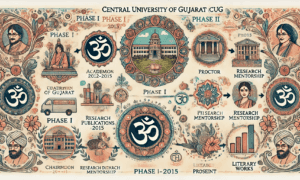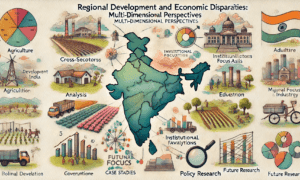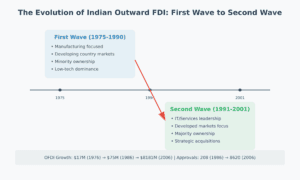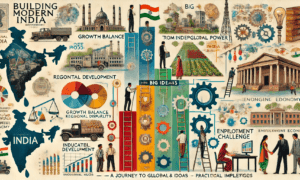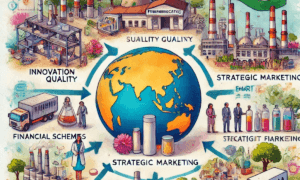PART 1: THE BIG PICTURE
The Changing Face of Indian Exports When India opened its economic doors in the 1990s, something remarkable happened. Trade, once a modest contributor to India’s economy, became a powerhouse – growing from a small stream to a mighty river that now makes up 42% of India’s GDP. But peek beneath this national success story, and you’ll find a fascinating tale of regional contrasts.
The Geographic Divide Imagine India’s export landscape as a detailed tapestry. Two regions – West and South India – dominate with vibrant colors, weaving together 76% of India’s manufacturing export story. The Western warriors (led by Gujarat and Maharashtra) and Southern stars (Karnataka and Tamil Nadu) have created export powerhouses. Meanwhile, other regions, despite their potential, contribute smaller patterns to this national fabric.
PART 2: THE SUCCESS FORMULA
What Makes Export Champions? Like master chefs with secret recipes, successful exporting regions share key ingredients:
- The Knowledge Foundation
- Strong technological capabilities
- Research institutions and innovation hubs
- Skilled workforce pools
- The Infrastructure Edge
- Modern ports (their gateways to global markets)
- Reliable telecommunication networks
- Strong financial institutions
- Well-developed urban centers
- The Policy Push
- Export-focused state policies
- Investment in business infrastructure
- Support for international business development
PART 3: THE PLAYERS
The Young vs The Established An intriguing pattern emerges when we look at who’s exporting. Younger firms, like fresh graduates eager to take on the world, show higher export intensity than their older counterparts. They’re often:
- More willing to take risks
- More adaptable to global standards
- More open to new markets and technologies
The SME Story: Hidden Champions in Waiting Small and medium enterprises present a compelling paradox:
- Only 3% currently export
- But those who do export show remarkable success when they:
- Invest in foreign technology
- Obtain quality certifications
- Locate in business clusters
- Operate from urban centers
PART 4: TALES FROM THREE STATES
Gujarat: The Merchant Prince Strengths:
- Strong business infrastructure
- Pro-business policies
- Excellent port facilities
Challenges:
- Over-reliance on petroleum products
- Limited SME participation
- Low R&D investment
Karnataka: The Strategic Innovator Success Factors:
- First state with dedicated export policy
- Strong focus on technology
- Balanced industrial development
- Active support for SMEs
Odisha: The Sleeping Giant Limitations:
- Rich in resources but poor in exports
- Lack of consistent industrial policy
- Infrastructure gaps
- Limited support for business development
PART 5: THE SURVIVAL GAME
The Three-Year Challenge Like restaurants in their first years, many exporters face a critical survival period:
- 27% drop out in the first year
- 51% exit within three years
- Only a select few become long-term players
Success Factors for Survival:
- Internal Strengths
- Adequate size and resources
- Strong R&D capabilities
- Modern technology
- International partnerships
- External Support
- Growing local markets
- Reliable infrastructure
- High-tech focus
- Urban advantages

PART 6: PRACTICAL ROADMAP
For State Governments
- Build Knowledge Infrastructure
- Invest in research institutions
- Create industry-academia linkages
- Support technology transfer
- Develop Physical Infrastructure
- Modernize ports
- Improve telecommunications
- Strengthen urban facilities
- Create Supportive Policies
- Offer targeted incentives
- Support quality certification
- Provide market intelligence
For Aspiring Exporters
- Investment Priorities
- Focus on technology upgradation
- Obtain quality certifications
- Build R&D capabilities
- Strategic Choices
- Consider urban locations
- Join industry clusters
- Seek international partnerships
- Resource Management
- Utilize government support
- Build financial strength
- Invest in human capital
The Road Ahead India’s export success story isn’t just about having resources – it’s about creating ecosystems that enable firms to compete globally. While some regions have found their formula for success, others are still writing their chapters. The future belongs to those who can combine local strengths with global standards, supported by smart policies and persistent execution.
Academic Abstract:
This study examines the spatial determinants of manufacturing exports in India during 1991-2008, with particular focus on sub-national patterns and regional factors influencing firms’ export behavior. Using a novel dataset of 8,486 manufacturing firms that accounts for 58% of national manufacturing exports, the research develops and applies a new methodology for estimating state-level exports by allocating firm-level exports to their locations of production. The analysis reveals significant regional concentration of manufacturing exports, with West India and South India accounting for 76% of national manufacturing exports by 2008. Through fractional logit estimation, the study finds that regional factors like technological knowledge stock, infrastructure quality, urban agglomeration, and specialized industrial structure significantly influence firms’ export intensity, beyond traditional firm-specific determinants. Analysis of export survival using discrete-time duration models indicates that only 49% of export spells survive beyond three years, with significant variation across regions. The research also examines export behavior of SMEs across regions and presents detailed case studies of Gujarat, Karnataka and Odisha to understand how sub-national policies shape firms’ internationalization. The findings suggest that regional export performance is strongly linked to state-level technological capabilities, infrastructure development, and policy support. The study contributes to understanding the role of sub-national factors in firms’ export competitiveness and provides policy recommendations for promoting regional export growth in developing economies.
Learn More:
Full citation: Pradhan, Jaya Prakash and Keshab Das (2016), Manufacturing Exports from Indian States: Determinants and Policy Imperatives, New Delhi & New York: Springer.
Learn More:




